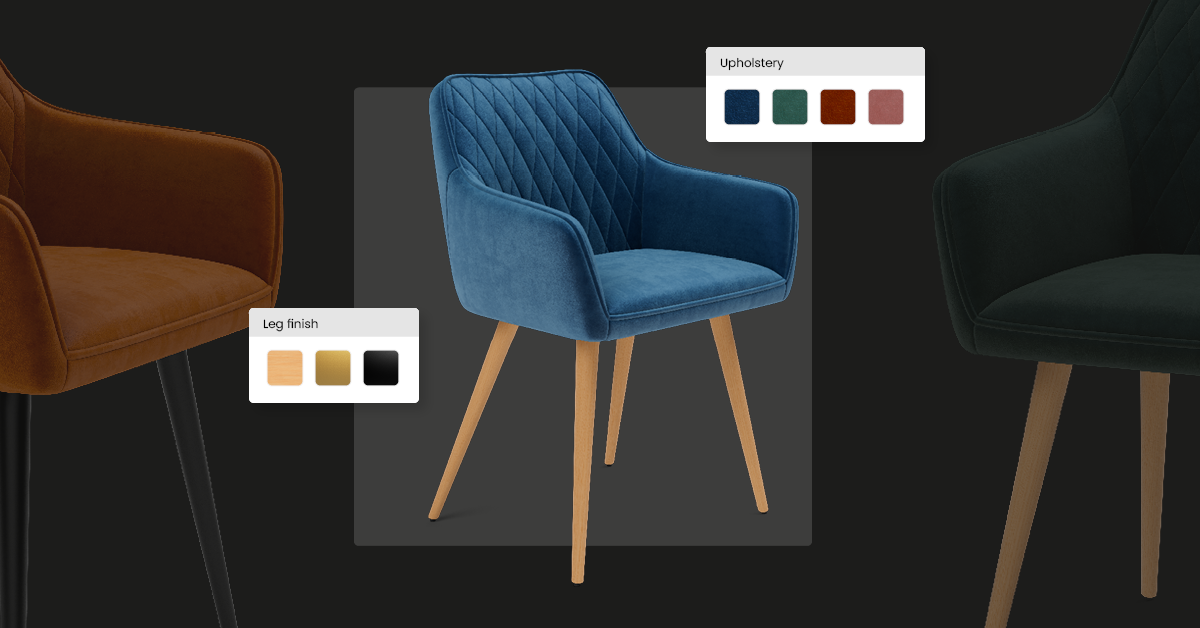As the furniture e-commerce landscape becomes more competitive, standing out to customers is vital.
3D product visualization software is one of the best ways to enhance a product listing and the overall shopping experience through explorative buying, customizable options, AR product configurations, and more. It's also a win for business owners, offering cost savings in product visualization and faster iterations. Let's explore 3D product visualization and its effect on furniture e-commerce content optimization in further detail.
What is 3D product visualization?
3D product visualization involves creating a digital three-dimensional representation of a product being sold. It allows customers to see and interact with the product, inspecting it from every angle, and even customize its color, texture, form, and size. This process gives greater customer control and sets proper expectations of what they will buy before making the final purchase at checkout.
Implementing 3D product representations through photorealistic rendering has had a positive effect on various market verticals and consumers, but it has become even more important for big-ticket items, such as products in the furniture, electronics, and automotive industries. Customers want to be sure they are making a good investment that will last them a long while. And when customers feel confident about a purchase, they are more likely to recommend the brand to others and effectively boost social proof.

Techniques and tools for 3D product visualization
3D modeling software like 3ds Max and Maya have enabled businesses to create product visuals focusing on aspects including its physical body, UV mapping, texture, opacity, and reflection. The next step of the process, rendering, involves digital lighting setups, cameras, and high-quality materials, all used to depict how the final product would look in reality, accentuating the product's physical properties and features, and ensuring brand consistency.
In essence, rendering software photographs each pixel of the image, calculates its color, and tracks rays of light as they would bounce around in real life. There's quite a lot of physics involved, and in many cases, the process takes a while, even on the fastest computers.
Luckily, this is not the case when using Cylindo, Chaos's all-in-one 3D product visualization platform. With Cylindo's 360 Viewer, you render 32 frames of the product, where the product itself rotates for 360 degrees and the camera is static. This process proves to be much faster. For the rendering of products, there are five pre-done lighting setups and three camera heights from which you can choose. But this can also be modified according to your requests.

Advantages of 3D product visualization
With any new process, it's only natural to be curious about what it will bring to your business before deciding whether to implement it. We list the many advantages of 3D product visualization in detail below.
Cost and time savings in product development
Businesses will experience a great reduction in prototyping costs. This is because virtual prototypes eliminate the need to source high-quality materials and assemble physical prototypes. Paired with faster iterations, any changes and improvements will help speed up development and foster an environment of innovation and efficient communication. 3D product visualization also reduces the need for physical marketing materials.
Need some proof? Consider FEST, which has saved thousands of euros in photography costs, or Riverside Furniture, which managed to save up to $100,000 annually with Cylindo Studio, entirely eliminating the cost of print catalogs and enhancing the way customers interact with their products. These are only a couple of examples of brands that have leveraged the power of 3D product visualization to save considerable time and money.
High-quality visual representation of products
3D product visualization provides customers with highly detailed images that showcase the features of the product accurately. Enhanced presentation with multi-angle views provides comprehensive product insight, while product customization displays allow customers to see all possible options and configurations. As previously mentioned, customers want to know exactly what they are getting. Showcasing your product in its entirety with all possible customizations boosts the level of trust and sets customer expectations straight from the get-go. Prioritizing photoreal rendering for your e-commerce business, means customers are more likely to make a purchase and be happy with it once it arrives at their doorstep.
Showcasing products in online shopping platforms
3D product visualization allows for a variety of ways to showcase products online. There are interactive displays, in which engaging 3D models respond to the touch or movement of the customer and offer a truly immersive and interactive experience, while enhanced product pages focus on presenting engaging and informative content, leading to higher conversions. Take a look at the furniture retailer Heal's, for example, which saw immediate growth once displaying all color and style options with Cylindo Viewer.
Virtual try-ons or AR experiences help customers visualize products in their real-life environments for better decision-making when shopping online. Cylindo AR, a web-native solution, allows customers to place 3D models of selected products in the real world directly from the browser, eliminating the need to download a mobile app. Curious about the impact of implementing Cylindo AR? Yardistry, a Canadian outdoor brand managed to double their e-commerce sales YoY while decreasing photography costs at the same time.
Building on the initial success of Cylindo AR, EQ3, a leading Canadian furniture design and manufacturing company, enhanced the desktop product page experience by featuring a QR code that appears when customers click the “View in AR” button, increasing user adoption of AR, and as a result, seeing a 36% increase in conversions, an 88% increase in average order value (AOV), and a 116% increase in page views.
Bridging the gap between physical and digital product experience
Finally, if you'd like bridge the gap between the physical and digital experience, making the most out of the marketing channels available and showcase your products to a wider audience, then 3D product visualization is the way to go.
Offering a 360 rendered view of your products, lets your potential customers interact with what you're selling in a way that is close to handling them in real life, in turn setting realistic expectations. Creating these immersive shopping experiences builds trust in your brand and enhances the customers experience leading to improved decision making. Detailed visuals aid informed decisions on purchases, reducing returns. Looking for a way to persuade customers to finish checkout and improve conversions?
To persuade customers to complete their checkout process and improve conversions, Cylindo’s Content API plays a crucial role. It seamlessly integrates high-quality visuals across your e-commerce platform, ensuring that every product view, including cart thumbnails, is as engaging and detailed as possible. Relying on high-quality photoreal 3D product visuals, allows for greater consistency across channels, creating a uniform product representation across the platforms you are advertising on.

Enhancing customer experience through 3D product visualization
You may still be wondering how exactly 3D product visualization enhances the customer shopping experience. There are a few key things to consider that 3D product visualization excels in: showcasing the product value, offering increased engagement, and unlimited customization options.
Enhancing the shopping experience
One of its strongest aspects is visualization of usage that demonstrates the product's features in action (i.e. its durability, value, and functionality) through dynamic presentations like 360 view renders, videos and animations.
Personalized experiences can then be created in the form of real-time customization, which boosts customer satisfaction. And here's something more: engaging visuals are more likely to be shared, increasing brand visibility.
Increased customer engagement and interactivity
These captivating visuals not only engage your potential customers giving them a clear sense of the product, but are more likely to boost social sharing. The buzz created on social media opens a window of customer preferences giving businesses a glimpse into which product features customers are excited about and which need improvement.
Customizable product options and configurators
In 3D product visualization for e-commerce, customization for ecommerce can often be overlooked but is absolutely critical for customer satisfaction, making it easy for customers to design their perfect products. User-friendly configurators contribute to boosting customer satisfaction by meeting specific needs, which increases customer loyalty.
One of the major advantages of Cylindo Studio is that it greatly reduces the costs and time required for traditional photography, increasing purchase intent by up to 64%, while offering customizable templates that are consistent across all channels. And just how much customization is possible? 10 to the 36th power, or an undecillion.

“With Cylindo, you can enjoy stunning 4K zoom to examine product details closely, 360-degree spins for complete views, and a product configurator to show all of the different material options. As all of the frames are pre-rendered, it delivers super fast performance. Cylindo Studio also produces lifestyle imagery, featuring products in realistic scenes with multiple camera angles to show how they look in real-world settings.”
- Jostein Pedersen, VP Product - 3D Commerce, Chaos

Trends and innovations in 3D product visualization
As technology races ahead, the world of 3D product visualization is welcoming in some cool trends that are changing the way we do our online shopping, allowing customers to see and interact with products in new and exciting ways, and pushing businesses to rethink their ecommerce strategy and implement these innovations across their marketing channels.
Augmented reality (AR)
Augmented reality has quickly entered the furniture industry as a technology helping empower businesses to elevate their product listing through immersive customer experiences. AR solutions enable customers to explore products in a virtual space for a deeper understanding of what they are buying before they finalize their purchase.
Virtual Reality (VR)
Virtual reality technology is transforming 3D product visualization by offering immersive and interactive experiences that allow customers to explore products in a highly engaging manner. In the fashion and furniture industries, VR enables customers to virtually try on clothes or enter virtual showrooms to experience how a piece of furniture would look and fit in their space, enhancing their shopping experience and making it more personalized.
Integration of AI and machine learning
AI has quickly entered the furniture e-commerce space and is offering solutions to improve the customer experience and drive business growth. By integrating AI, furniture brands can streamline their operations, personalize customer experiences and optimize marketing strategies, in turn resulting in higher ROI.
AI tools are increasingly being used for product visualization and lifestyle imagery creation, with 56% of furniture businesses leveraging AI to automatically generate or modify images. Furthermore, 52% utilize AI for image recognition and classification, while 42% use it for real-time customization of product imagery. With 61% of furniture businesses already adopting AI for customer support and recommendations, it looks like AI in furniture e-commerce is here to stay and will only continue to grow in its adoption.
Dive deep into the trends
Would you like to gain an even better understanding of the current e-commerce landscape in the furniture industry and gain expert insights on what will give you a competitive edge? Make sure to check out this whitepaper: Tech trends impacting the furniture industry: from AI to 3D product visualization.

Customizable products and the role of 3D visualization
We've already touched a bit on the benefits customization brings potential customers through 3D visualization. But let's explore how these benefits directly enhance customer satisfaction and drive sales even further.
For British furniture retailer Heal's, sofas aren't just products—they're a passion. To communicate the level of quality and beautiful craftsmanship that goes into their creation across to their potential customers, they relied on Cylindo to showcase unlimited customization of all available upholstery and finishes in 360-degree views.

“By having Chaos Cylindo, we bring the website experience closer to the in-store experience. Allowing the customer to visualize and interact with the product in 3D increases the sales we can make.”
- Mark Hammond, Head of E-commerce, Heal's
This quickly resulted in sofas becoming the best-performing category on their website. Heal's also witnessed reduced returns and maximized its ROI by working with Cylindo's Customer Success Team.
Ever wondered how QR codes can transform furniture shopping into a fun and interactive experience? Wayfair has the answer. Customers can engage with Wayfair's Digital Design Studio either through guidance from designers at Wayfair’s Design Bar or by discovering it on their own. Upon approaching the kiosk, they place product cards on a glass tabletop to see photorealistic visualizations on a screen, allowing them to mock up and customize a living room with matching furniture, compare products, and purchase items via QR codes on the cards. Learn more about Wayfair's Digital Design Studio and how they have approached customizable product options with the help of Chaos Vantage.
Embracing the future of 3D product visualization
In the early days of e-commerce content optimization, 3D product visualization was a novelty, but it has since evolved into a powerful tool that creates a perfect harmony between digital and physical shopping experiences. We've defined what 3D product visualization is, the techniques and tools involved in the process, and the many advantages it brings to e-commerce businesses.
Looking ahead, the trends show us that the future of product visualization looks promising, with advancements in AR, VR, and AI leading the way. These technologies will continue shaping the shopping experience for customers, making it more fun, immersive, and personalized. As a 3D visualization company, we are thrilled to be a part of that journey! We invite you to join us in defining the future of visualization.
FAQs:
What is the difference between 3D visualization and 3D modeling?
3D modeling is the initial step of creating realistic digital representations, laying the foundation for 3D visualization. It is the process of creating a three-dimensional representation of an object, while 3D visualization is a term which encompasses everything that goes into rendering the model into a photoreal image or engaging animation. The 3D visualization process includes texturing, materials, lighting, camera setups, scene composition, adding entourage and interactive elements, rendering, and post-production.
What are the principles of product visualization?
The main principles of product visualization include visual accuracy, realism, and interactivity. Together, these principles ensure that the final visual representation of a product is truthful and engaging, and enhances the customer experience.
What are the benefits of using 3D visualization for furniture e-commerce?
Using 3D visualization for furniture e-commerce provides several benefits which both enhance the customer experience and drive business growth for the retailer. Some of the advantages include cost and time savings for product development, high-quality representation of products, interactive showcasing in shopping platforms, and improved decision-making by setting realistic expectations for customers.
How does 3D visualization improve conversion rates in furniture e-commerce?
3D visualization improves conversion in furniture e-commerce by providing customers with a more informative and engaging experience through detailed visualization that gives an understanding of the product’s features, design, and materials. Interactive options, such as augmented reality, allow customers to customize and personalize the product to their preferences, reducing uncertainty and returns and increasing customer satisfaction through informed decision-making and accurate representation.
Can 3D visualization be used for all types of furniture?
3D visualization is best used for standard furniture items like sofas and chairs, tables and desks, beds, and bedroom furniture, where customers can test out different fabric and finish options, colors, and styles. It’s also great for modular furniture software, where customers can set up separate pieces of furniture to best fit their space. Outdoor furniture, such as patio and garden sets, where customers can see how the furniture will look in different colors and textiles, is also achieved well with 3D visualization.
What is the best 3D visualization software on the market?
The best 3D visualization software very much depends on your specific needs. For 3D product visualization, we believe that Cylindo offers furniture businesses the most comprehensive suite of solutions, specifically designed to enhance the shopping experience for retailers and brands. Book a free demo today to see how Cylindo can enhance your omnichannel customer experiences, reduce costs, and help boost your bottom line. We encourage you to explore and learn more about all Chaos products in order to find the solution that will best suit your workflow and drive you to create your best work.



